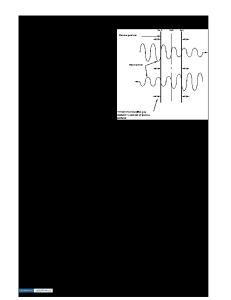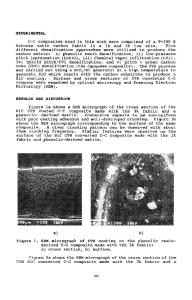Fabrication of carbon-carbon composites by forced flow-thermal gradient chemical vapor infiltration
- PDF / 2,959,724 Bytes
- 9 Pages / 576 x 792 pts Page_size
- 38 Downloads / 399 Views
W. Jack Lackey and Garth B. Freeman Georgia Tech Research Institute, Georgia Institute of Technology, Atlanta, Georgia 30332
Pradeep K. Agrawal School of Chemical Engineering, Georgia Institute of Technology, Atlanta, Georgia 30332
Matthew D. Langman Georgia Tech Research Institute, Georgia Institute of Technology, Atlanta, Georgia 30332 (Received 21 November 1994; accepted 13 February 1995)
Carbon fiber-carbon matrix composites were fabricated using the forced flow-thermal gradient chemical vapor infiltration (FCVI) process. The preforms for the infiltration were prepared by stacking 40 layers of carbon cloth in a graphite holder. The preforms were infiltrated with carbon using propylene or methane as a reactant, with hydrogen as a diluent. Composites with porosities as low as 7% have been processed within 8-12 h. The highest deposition rate obtained in the present study was ~ 3 yum/h, which is more than an order of magnitude faster than the typical value of 0.1-0.25 /im/h for the isothermal infiltration process.
I. INTRODUCTION Carbon fiber-carbon matrix composites offer unique capabilities for mechanical systems in high temperature (~1000-2000°C) applications where high strength, stiffness, toughness, and thermal shock resistance are desired, as well as light weight. These composites are considered for use as jet engine components, nose cones, aircraft disk brakes, and leading edges on the space shuttle and high speed aircraft.1 Recently, the range of applications has been broadened to include thermal management in electronic components and aerospace structures where the high thermal conductivity of carbon-carbon composites is advantageous. Lackey and Starr2 have reviewed recent developments in the CVI of carbon-carbon. Kotlensky3 has prepared an excellent review of early carbon-carbon CVI work. Carbon-carbon composites are at present fabricated using many cycles of resin or pitch infiltration followed by carbonization and graphitization, or by the use of the isothermal chemical vapor infiltration process (CVI).2"5 In the CVI process, large isothermal furnaces (hot zone of 1.8 m diameter and length of 2.0 m) containing multiple parts predominate. A hydrocarbon gas is flowed through the furnace at reduced pressure. The gas diffuses into the fibrous preforms and reacts to deposit the carbon matrix on the carbon fibers. In this case, the deposition occurs preferentially near the outer surface of the preform (Fig. 1) because the concentration of the reagent is at its maximum value near the J. Mater. Res., Vol. 10, No. 6, Jun 1995 http://journals.cambridge.org
Downloaded: 30 May 2014
outer surface and reduces drastically on progressing inside the preform. Also, this preferential deposition tends to cause blockage of pores due to deposition of an impermeable coating at the outer surface. Consequently, the infiltration process must be interrupted to machine the impermeable skin to facilitate the reagent flow into the preform.3 The isothermal CVI process has to be carried out at low temperatures and pressures in o
Data Loading...











